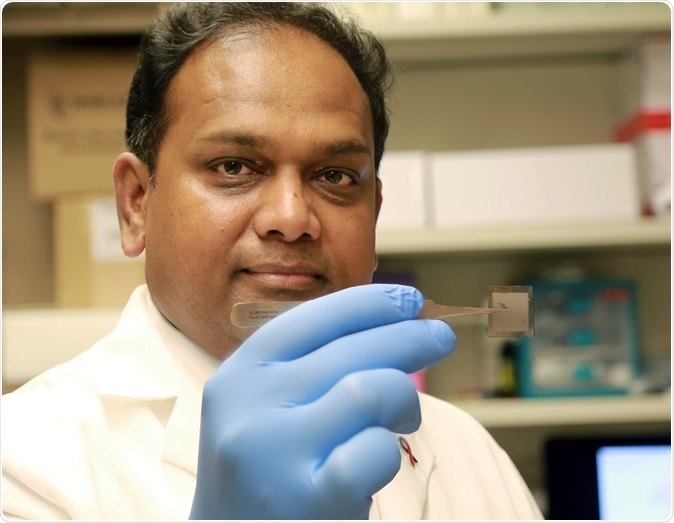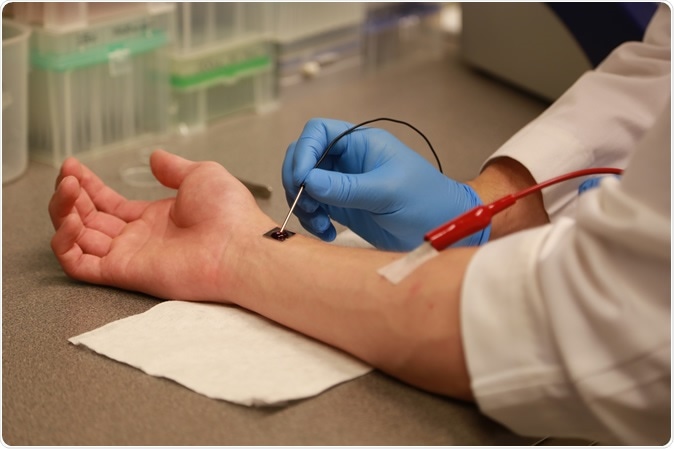
Nanotechnology wonders: Organ healing with a single touch!
Scientists from the Ohio State University Wexner Medical Centre have come up with what sounds like a science fiction - a nanotechnology device that can switch the cell functions in such a way that the failing organs are revived using a single touch. This technique is called Tissue Nanotransfection (TNT) and the tiny nanotechnology devices inject a new genetic code into the skin cells. These genetically modified skin cells then transform into other types of cells that can help in the regeneration of the diseased cells. The study is published in the journal Nature Nanotechnology, authored by Daniel Gallego-Perez and team.

Chandan Sen, PhD, holds a chip that could revolutionize medical care. In laboratory tests on mice at The Ohio State University Wexner Medical Center, the chip was able to heal serious wounds with a single touch by converting skin cells into vascular cells. Image Credit: Ohio State University
Dr. Chandan Sen, director of the Center for Regenerative Medicine and Cell-Based Therapies at The Ohio State University Wexner Medical Center explains that the chip would take only a single touch and a fraction of a second. As soon as it touches the wounded area, the cells begin to reprogramme into something different. For example they used the chip in the labs on injured legs of mice he said. The injured legs had little or no blood supply and were damaged to begin with. The chip instructed the skin cells to turn into blood vessel cells or vascular cells. The skin cells thus started becoming vascular cells and in a week improvement began noticeably. Within the second week the blood vessels were fully formed to the injured leg and by the end of third week the leg was saved with nothing other than the wonder nanochip.

Researchers demonstrate a process known as tissue nanotransfection at The Ohio State University Wexner Medical Center. In laboratory tests, this process was able to heal the badly injured legs of mice in just three weeks with a single touch of this chip. The technology works by converting normal skin cells into vascular cells, which helped heal the wounds. Image Credit: Ohio State University
Study collaborator Professor L. James Lee of chemical and biomolecular engineering department at Ohio State explained that this was gene therapy. He added that this concept was not a new one and has been studied for quite some time now. What is new is the delivery of the DNA that needs to be inserted into the host genetic code.
The chip with the device contains a special genetic code that is encoded within proteins. A small electrical current passes through the skin as it is placed over the skin of the test animal. This creates an electric channel from the chip to the skin cells. Though these channels the DNA or RNA – genetic materials, are injected into the skin cells. These injected genetic materials then start to reprogramme the skin cells into becoming what they are programmed to become.
The technique worked with 98% efficiency say the researchers led by Daniel Gallego-Perez an assistant professor of biomedical engineering and general surgery and previously a postdoctoral researcher in both Sen’s and Lee’s laboratories.
Perez explained that there are two parts of this technology;
- The designed nanochip that would deliver the genetic load to the living adult cells of the body
- The actual design of the genetic material that is to be transferred.
Dr. Sen said that the skin cells or any type of tissues this technology was applied could become anything the researchers wanted them to become. For example in laboratory mice with brain stroke, the skin cells were coaxed to become brain cells. The new brain cells of the mice grew from the skin cells. They were then harvested or grown in the laboratory and finally injected back into the brains of the mice. Within a few weeks after the stroke, the mice had restored brain function and they were found to be completely healed from the stroke.
What is wonderful is that the technique does not depend on externally applied medications. Since it uses the patient’s own cells, the technique could get approval for human clinical trials within a year feel researchers. Till now it has been shown to be effective in laboratory animals such as mice and pigs. It could be a breakthrough in repairing injured tissues, restoring functions to the aging tissues such as blood vessels, organs and nerve cells. Not wrongly Sen called the skin a “fertile land” where elements from any failing or declining organ may be grown. Further the chip is not implanted within the patient and also does not affect the immune system in any manner. So no worries about long term effects or suppression of immunity are necessary explained Dr. Sen who also is executive director of Ohio State's Comprehensive Wound Center.
This research was funded by Leslie and Abigail Wexner, Ohio State's Center for Regenerative Medicine and Cell-Based Therapies and Ohio State's Nanoscale Science and Engineering Center.























.png)











No hay comentarios:
Publicar un comentario